
 |
 |
| Guest houses | Book now | Links | The Villa |
| Duet | Trio | Quartet | Services | The garden | Species of plants |
| Four holiday seasons in the Lake Maggiore area | Places of interest | News and events |
| Verbania | Mountains and valley | The lakes |
| History of Villa Rusconi-Clerici | Contacts | Useful information | Where we are |
| Species of plants | 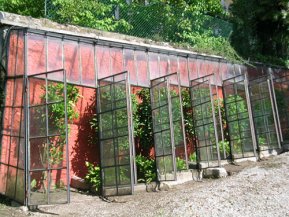
|
|
 A historic garden is a fascinating world in miniature. The plants may be large or small, showy or modest, but all are of great interest.
A historic garden is a fascinating world in miniature. The plants may be large or small, showy or modest, but all are of great interest.
Such a living world is in continual evolution. The owners can try to direct this evolution, but the major part is played by nature, through snowfalls, disastrous storms, seeds carried by birds or the wind. Managing this fragile equilibrium in a rational and discreet fashion, and with loving care, through problems and satisfactions, is the mark of the true gardener.
 As our garden is not as large as many others, we are constantly torn between introducing new plants, following the example of the 19th century botanists, and just maintaining the original plants as we remember them.
As our garden is not as large as many others, we are constantly torn between introducing new plants, following the example of the 19th century botanists, and just maintaining the original plants as we remember them.
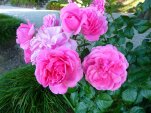 There is no doubt that the camellias and roses are our favourites, and the garden from March to June is an exceptional sight, with its riot of colours, shapes and varieties.A further source of pride is that some of our camellias are over 150 years old and are extremely rare, in a few cases actually unique.
There is no doubt that the camellias and roses are our favourites, and the garden from March to June is an exceptional sight, with its riot of colours, shapes and varieties.A further source of pride is that some of our camellias are over 150 years old and are extremely rare, in a few cases actually unique.
Nowadays we owe a debt of gratitude to internet for the amazing opportunity it gives us to consult English, German and American web sites in particular; the botanical background in these countries has fostered great advances in scientific knowledge. It’s always an odd feeling to converse with our foreign visitors using the Latin names of trees and flowers as a lingua franca!
 The species present in the garden are listed below in alphabetical order, subdivided by category, not very scientifically: Trees, Palms, Shrubs, Bamboos, Climbing plants, Flowers / herbaceous plants / ground cover plants / ferns. We have used primarily the botanical Latin name, sometimes including the common name. The rarest species, or those present with particularly numerous or important specimens, are marked with an asterisk.
The species present in the garden are listed below in alphabetical order, subdivided by category, not very scientifically: Trees, Palms, Shrubs, Bamboos, Climbing plants, Flowers / herbaceous plants / ground cover plants / ferns. We have used primarily the botanical Latin name, sometimes including the common name. The rarest species, or those present with particularly numerous or important specimens, are marked with an asterisk.
We do realise that this list is not scientific; it is also not definitive, due to the fact that every year some variety disappears, or appears, or is planted. However, we think it right to try and keep the list up to date. We shall always be pleased to give our guests details of the plants in the garden, leaving it to them to judge the results of our efforts – and please feel free to offer your suggestions!
Trees 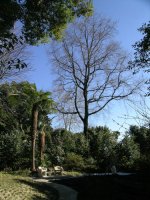 Acacia dealbata (mimosa)
Acacia dealbata (mimosa)
Acer japonicum
Aesculus hippocastanus
Arbutus unedo (corbezzolo)
Camellia japonica (40 cultivar)*
Camellia sasanqua
Canfora*
Carpinus
Cedrus atlantica
Cornus
Diospiros kaki (caco)
Eriobotrya japonica (nespolo)
Fagus asplenifolia*
Fagus sylvatica
Ginkgo biloba
Ilex aequifolium (pungitopo)
Laburnum vatereri (maggiociondolo)
Laurus cerasus
Laurus nobilis
Ligustrum lucidum
Ligustrum ovalifolium
Ligustrum japonjcum
Liquidambar
Liriodendron tulipifera
Magnolia grandiflora* 
Magnolia japonica
Magnolia stellata
Nerium oleander*
Nyssa sylvatica*
Olea fragrans
Osmanthus
Paulonia
Platanus
Prunus armeniaca (albicocco)
Pumila punica (melograno)
Quercus ilex
Rhododendron (5 cultivar)*
Sequoiadendron gigantea
Sofora japonica *
Stewartia pseudocamellia *
Taxus baccata
Thuja
Viburnum tinus
Viburnum opulus
Palms
Butia yatay*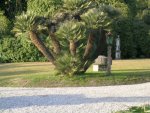
Chamaerops humilis *
Erithea armata*
Phoenix canariensis
Trachycarpus fortunei*
Washingtonia filifera*
Shrubs/Bamboos
Abelia floribunda
Aralia
Aspidistra*
Azalea (15 cultivar) *
Aucuba japonica
Banano
Buxus
Calathea
Chusquea
Citisus
Datura *
Deutzia
Edgewortia *
Eleagnus pungens
Fargesia simba
Forsythia
Gardenia
Genista
Hypericum
Indocalamus
Lagestroemia
Mahonia
Nandina
Phillostachys aurea
Photinia
Pieris
Pleioblastus linearis
Potentilla
Pseudosasa japonica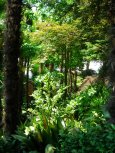
Rhus cotinus
Rosmarinus
Syringa vulgaris
Skimmia
Spiraea aurea
Spiraea japonica
Weigela
Yucca
Climbers
Ampelopsis 
Bignonia
Bougainvillea
Caprifoglio
Clematis armandi*
Clematis tetrarosae
Ficus repens
Hedera
Jasminum nudiflorum
Plumbago
Vitis
Wistaria (glicine)
Flowers/Herbaceous plants/Ground cover plants/Ferns  Agapanthus
Agapanthus
Agave
Ageratum
Aloe
Anthirrinum (bocca di leone)
Aster
Astilbe
Ceanotus
Convallaria
Cyclamen
Desmodium penduliflorum
Dhalia
Felci (5 specie)
Gladiolo
Iris
Hedera
Hosta 
Lantana
Lavandula
Lilium
Lippia citriodora (limoncino)
Pachisandra repens
Paeonia
Pelargonium (geranio)
Phlox
Rosa* (20 cultivar)
Salvia splendens
Sassifraga
Sempervivum
Tagetes
Tradescantia
Vinca minor
Zinnia
 In the lemon-house
In the lemon-house
Orange
Bergamot
Arum lily
Kumquat
Lemon
Mandarin
Lily of the Valley
Grapefruit
In the Winter Garden
Asparagus plumosus
Begonia (5 species)
Cycas revoluta
Hoya carnosa
Jasminum officinale
Orchidea (4 varieties currently being tested)
Rincospermum
Tibouchina
…plus overwintering plants.
In the Old Greenhouse
The old greenhouse has been left as it was, with its original iron structure.
The numerous varieties of ferns, allowed to grow spontaneously with a minimum of selection, give the greenhouse a quite distinctive atmosphere.
In the kitchen garden (depending on the time of year…)
Aubergines, tomatoes, celery, cabbages, pumpkins, courgettes, basil, rosemary, sage, parsley, chilli, etc
You may smile at our including these “kitchen plants”, but we are proud of our vegetables too! We still remember how after the war we used the skins of angora rabbits raised in the greenhouses to keep us warm, and ate eggs from the hens that scratched about in the tennis court.